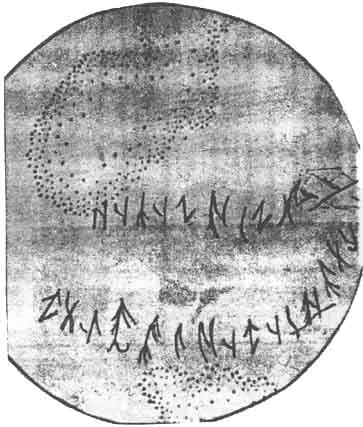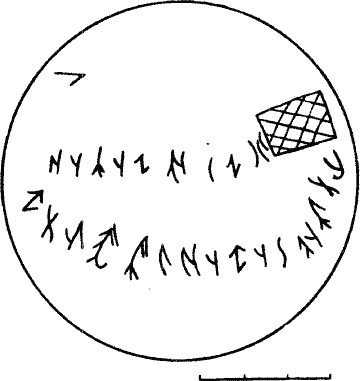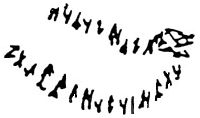A.Amanjolov
Proto-Türkic rune-like inscription on silver cup
(Issyk Inscription)
A.S. AMANJOLOV
HISTORY OF ANCIENT TÜRKIC SCRIPT
Almaty, "Mektep", 2003
Introduction
The oldest inscription in Türkic alphabet, the Issyk Inscription, written on a flat silver drinking cup, was found in 1970 in a royal tomb located within Balykchy ( Issyk), a town in Kyrgyzstan near Lake Issyk, and was dated by 5-th c. BC. In the tomb was a body of a man dressed from head to toe in magnificent attire, the clothes, jacket, pants, socks, and boots all had a total of 4,800 attached pieces of pure gold, greatest ever found in a tomb except Pharaoh Tutankhamen. The top of cone-shaped crown covering ears and neck carried golden arrows emblem. A sword on the belt right side and a knife on the left were in sheaths. Beautiful relief ornaments of animal art decorated shields, belt and front of the hat. Radiocarbon tests determined the age of the finds as belonging to the fifth century B.C. What was the world in the 5-th century BC? We have archeological discoveries, where dating is almost always somewhat speculative, and reconstructions of the ancient Greek maps, and the views of the Mesopotamian and Chinese records. From the Mesopotamian, Chinese, and Greek texts, from the archeological discoveries of the kurgans, from the written monuments, we get a glimpse of the nomadic nations of the Central Asia in the 5-th c. BC. The various interpretations of the graphics and contents of the inscription witness the paucity of the finds and the potential for the studies.
For a listing of other images, publications and attempts to read click here
~ekerilaz/princess.html

Links
http://www.lostlanguages.com/saka.htm
http://public.kubsu.ru/~usr02898/sl6.htm
Issyk Scythian Inscription
À. Àmanjolov
Chapter 6
R. ILI RUNIC AND GREKO-GRAPHICAL INSCRIPTIONS
Proto-Türkic rune-like inscription on silver cup
In the same timbergrave were various utensils (up to thirty objects): rectangular wooden dishes, thin-walled clay vessels, ornamented bowls of silver and bronze, silver spoon (spoon handle in shape of a bird head with a long beak), and at last, a silver cup with mysterious runic-like inscription (see amended sketch).
| Photograph from http://www.lostlanguages.com/saka.htm by Dr. Selahi Diker |
Proto-Türkic runic-like inscription Silver cup of 5th-4th c. BC kurgan r. Ili Amended sketch by the author |
Rendering by
enthusiastic Iranist S. Ryabchikov http://public.kubsu.ru/~usr02898/sl6.htm |
 |
 |
|
All inventory of the burial was sent for processing to the department of archeology in the C.C.Valihanov Institute of History, Archeology and Ethnography (Kazakhstan). At last, in the autumn of the 1970 we received a first opportunity to study directly the objects from the Issyk kurgan, including the silver cup with inscription. In many attributes this burial belongs to the 5th-4th cc. BC, as roughly estimated the extremely cautious K.A.Akishev1 (carbon dating of Issyk kurgan) .
The inscription is etched with a sharp object on the external side of the silver cup and consist of 26 runic-like letters located in two horizontal lines. A top line runs across the center, a bottom line is on the convex surface of the cup. Both lines begin from a shaded rectangle. The top line has 9 letters, the bottom has 17 letters (including a letter located separately at the end of the line, after a damaged part). These letters display similarity with letters of Mediterranean early alphabetic scripts2, and with Ancient Türkic runes. To what degree this mysterious similarity is supported by similarity of phonetic sounds of the compared letters? We shall try to answer this question based on our reading of the inscription that follows.
Paleography of the inscription:
1) The letter
![]() γ corresponds to the Orkhon-Yenisean letters
γ corresponds to the Orkhon-Yenisean letters
![]() γ,
compare
γ,
compare
![]() q in Lician alphabet of the 5th-4th cc. BC from Asia Minor and
q in Lician alphabet of the 5th-4th cc. BC from Asia Minor and
![]() h in Venetian alphabet (a
version of Etruscan alphabet);
h in Venetian alphabet (a
version of Etruscan alphabet);
2) The letter
![]() a (ä) is used twice, it is widely
represented in the Türkic runic of Talas and upper Yenisei
with the same sound, compare Orkhon letter
a (ä) is used twice, it is widely
represented in the Türkic runic of Talas and upper Yenisei
with the same sound, compare Orkhon letter
![]() a, ä;
a, ä;
217
3) The letter ![]() s corresponds to Talas and Yenisei runic
letter
s corresponds to Talas and Yenisei runic
letter
![]() s of a soft syllable, and also to the Orkhon
s of a soft syllable, and also to the Orkhon
![]() s ~ ŝ of a soft or (rarer) of a firm syllable;
s ~ ŝ of a soft or (rarer) of a firm syllable;
4) Letters ![]() η (?) and
η (?) and
![]() n display a relationship with the
Phoenician letter
n display a relationship with the
Phoenician letter
![]() n and with Yenisei runic letter
n and with Yenisei runic letter
![]() n of a
soft syllable (Monument No 46), and even more so with
the letter
n of a
soft syllable (Monument No 46), and even more so with
the letter ![]() n in ancient
Greek, Carian (Asia Minor) and
some Italic alphabets (Lepontian, Messapian,
Pitsenian, Oskian) of the 1st millennium BC;
n in ancient
Greek, Carian (Asia Minor) and
some Italic alphabets (Lepontian, Messapian,
Pitsenian, Oskian) of the 1st millennium BC;
5) The letter
![]() q corresponds to the Orkhon-Yenisean
q corresponds to the Orkhon-Yenisean
![]() q, compare
Mediterranean alphabetic letters of the 2nd-1st millenniums BC, the N.Semitic
q, compare
Mediterranean alphabetic letters of the 2nd-1st millenniums BC, the N.Semitic
![]() h (kh), Cyprus-Phoenician
h (kh), Cyprus-Phoenician
![]() h, kh, Aramean
h, kh, Aramean
![]() h;
h;
6) The letter
![]() u(ü), î, ö is used five times, compare
N.Semitic
u(ü), î, ö is used five times, compare
N.Semitic
![]() w in the inscriptions of the 2nd-1st
millenniums
BC, the ancient Greek
w in the inscriptions of the 2nd-1st
millenniums
BC, the ancient Greek
![]() u, the eastern
Greek
u, the eastern
Greek
![]() u, ü, the
western Greek
u, ü, the
western Greek
![]() u, Lydian
u, Lydian![]() u (1st millennium BC), and the Türkic runic letter
u (1st millennium BC), and the Türkic runic letter
![]() ö, ü;
ö, ü;
7) Letters
![]() č belong to the sphere of Türkic runes, corresponding to the Yenisei
č belong to the sphere of Türkic runes, corresponding to the Yenisei
![]() č, and probably to runic letters
č, and probably to runic letters ![]() č on the Talas plank, considering
the reading suggested by S.E.Malov3;
č on the Talas plank, considering
the reading suggested by S.E.Malov3;
8) The letter
![]() b
of a soft syllable corresponds to the Aramean
b
of a soft syllable corresponds to the Aramean
![]() b (5th-4th cc. BC), which
in turn goes back to N.Semitic, Phoenician
b (5th-4th cc. BC), which
in turn goes back to N.Semitic, Phoenician
![]() b (2nd-1st millenniums
BC), compare
b (2nd-1st millenniums
BC), compare
![]() b
of a soft syllable in the Yenisei
inscriptions;
b
of a soft syllable in the Yenisei
inscriptions;
9) Letters
![]() z are identical to
runic letter
z are identical to
runic letter
![]() z
of the Talas and
Yenisei inscriptions, and to runic letter
z
of the Talas and
Yenisei inscriptions, and to runic letter
![]() z of the Orkhon inscriptions
of the 8 century;
z of the Orkhon inscriptions
of the 8 century;
10) The letter
![]() ê is closest to the letter
ê is closest to the letter
![]() ê
of the 5th-4th cc. BC Aramean
alphabet, and corresponds to the
Türkic runic letter
ê
of the 5th-4th cc. BC Aramean
alphabet, and corresponds to the
Türkic runic letter
![]() ê, compare
ê, compare
![]() ê in the Phoenician-Aramean
alphabet of the 9-8 centuries BC;
ê in the Phoenician-Aramean
alphabet of the 9-8 centuries BC;
11) The letter
![]() b
of a firm syllable corresponds to the Türkic runic
b
of a firm syllable corresponds to the Türkic runic
![]() b
of a
firm syllable, and also to the ancient Greek
b
of a
firm syllable, and also to the ancient Greek
![]() b (Naxos, 7 century
BC) and
b (Naxos, 7 century
BC) and
![]() b (Korkir, 8 century BC);
b (Korkir, 8 century BC);
12) The letter
![]() q(uq) is used twice,
it corresponds to the Yenisei
q(uq) is used twice,
it corresponds to the Yenisei
![]() q (in
front or after o, u), to the letter
q (in
front or after o, u), to the letter ![]() kh in
Retian alphabet (a version of early Etruscan alphabet), Messapian
kh in
Retian alphabet (a version of early Etruscan alphabet), Messapian ![]() h and,
probably, is related to the letter
h and,
probably, is related to the letter ![]() êà in the Cyprian syllabic
script;
êà in the Cyprian syllabic
script;
13) Letter
![]() ï, i is used twice, it corresponds to the Türkic runic
ï, i is used twice, it corresponds to the Türkic runic
![]() ï, i, and also
to the notable Yenisei
ï, i, and also
to the notable Yenisei
![]() ï, i, compare the letter
ï, i, compare the letter
![]() i in
the Picenian alphabet of the ancient Italy;
i in
the Picenian alphabet of the ancient Italy;
14) The letter ![]() r (?) was not met earlier in the Türkic runic
inscriptions, its form reminds the Retian (northern Etruscan)
letters
r (?) was not met earlier in the Türkic runic
inscriptions, its form reminds the Retian (northern Etruscan)
letters
![]() z from Sondrio (prossibly, based
on phonetic
accordance r - z);
z from Sondrio (prossibly, based
on phonetic
accordance r - z);
15) Letter
![]() ä
is definitely approaching the Orkhon
ä
is definitely approaching the Orkhon
![]() à,
ä.
à,
ä.
A remarkable paleographic distinctiveness of the r. Ili cup inscription, like the inscription on a silver dish from the r. Yaik, is the absence of word separators.
As a whole, the paleographic analysis of the runic-like inscription agree completely with its archeological dating of the middle of the 1st millennium BC.
The runic-like inscription on the silver cup of
the Saka time, as can now be verified, is in Türkic and is read from right to left as follows:
218
Transcription

Transliteration and translation
(1) àγà sàηa očuq
= Aγa, saηa očuq!
"Senior brother, (this) hearth is for you!"
(2) bäz
čök boqun ičr(?)ä
uzuq ...i = Bez, cök! Boqun ičrä
[r?] azuq! ...i
"Stranger, kneel! Progenies [shall have]
food!"
Lexicon of the inscription:
àγà "senior brother, senior relative from a male
line",
compare Uigur legal documents of 13th century from Turfan oasis
aqa "senior brother, uncle"
4,
Kazakh, Kirgiz aga "senior brother, uncle",
Uzbek oga "senior brother",
Uigur aga-ini "brothers; senior and younger
brothers",
Yakutsk (Saka/Sakha), aga
"1) elder; 2) father",
Turkish, Azeri aga "master, boss";
![]() saηa
"to you", a dative case form from pronoun sen "you"
(singular),
saηa
"to you", a dative case form from pronoun sen "you"
(singular),
compare saηa "to you" in the inscription of "Tonyukuk Monument"
5;
očuq hearth (Slavic "ochag",
compare ancient Uigur očuq "hearth, stove", in "Divan lugat at-türk"
by Mahmud Kashgari očuq-očaq "hearth,
stove" (ATD, p. 362);
219
bez "stranger, alien, extraneous" this word is
written in Mahmud Kashgari spelled
![]() ,
and is inaccurately read baz6, instead of
bez, which quite naturally
corresponds to the Mongolian bər (beri) "sister-in-law, daughter-in-law" (this example
displays the "rhotacism" law and semantical development of a word). Compare
also Kirgiz bez kiŝi "1) insensible, thick-skinned
person; 2) introvert";
,
and is inaccurately read baz6, instead of
bez, which quite naturally
corresponds to the Mongolian bər (beri) "sister-in-law, daughter-in-law" (this example
displays the "rhotacism" law and semantical development of a word). Compare
also Kirgiz bez kiŝi "1) insensible, thick-skinned
person; 2) introvert";
čök is a imperative mood of singular 2-nd
person form for the verb čök "1) to descend, kneel; 2)
to descend, fall; 3) to submerge (in water)",
represented in the Cairo and Herat manuscripts of "Kutadgu
Bilig", in in the Mahmud Kashgari dictionary, and in
the ancient Uigur written monument "Altun yaruk " (ATD,
p. 154), and also in modern Türkic languages;
boqun (buqun) "generation, progeny",
compare paired nouns bodun buqun (boqun?) "population,
inhabitants" in ancient Uigur texts (ATD, p. 108,
125) (also Budini tribe mentioned
by Ptolemy in the N.Pontic),
boγun "joint, articulation" in Mahmud Kashgari (ATD,
p.
109),
Kazakh buyn (buwun) "1) joint; 2) generation" (jas
buyn "young generation"),
Karakalpak buüyn "1) joint; 2) knee
(element of something); 3) link (of chain); 4) generation " (γ > w)
Kirgiz buun-muun "1) joint, articulation; 2)
indirect.
generation; 3) indirect. posterity ";
ičrä [r?] "inside, inward" (ATD, p. 202), compare in "Kül-Tegin
Monument"; ičrä aŝsïz taŝra
tonsïz jabïz jablaq bodunta üzä olurtïm "I
had enthroned over miserable lowly people that did not have
food inside,
and clothes outside" 7;
azuq "food, provisions, alimentation, forage" (ATD,
p. 73),
compare Turkish azik "foodstuffs, edibles, the foodstuffs, provisions,
food",
Kazakh, Karakalpak azyq, " provolstvie, provisions,
alimentation; food",
Altai azyk "stock, supplies (provisions)".
The contents of this inscription testify to the ancient funeral ritual grounded in the belief in afterlife. The diseased needed a constant care of his relatives and dearest. The traces of the ritual are found and in the Ancient Türkic stone figurines representing the deceased with a bowl in the right hand, and also in the vestiges of similar representations among the Türkic-speaking peoples, including at Kazakhs8.
As the offered reading allows to judge, the inscription on the silver cup belong to fairly early version of the Türkic runes, associated closely with the alphabetical writings in the Mediterranean in the middle of the 1st millennium BC. This inscription is made in the Ancient Türkic language, which apparently spoke the early nomads of Jeti-Su area.
The examined inscription gives reasons to reconsider the traditional concept about an absence of alphabetical writing among the early Asian nomads, and gives a serious impetus for further scientific research.
***
220
The decoding of the proto-Türkic runic-like inscription on the silver cup, presented for the first time in 19719, remains unshaken, because of the absence among ideological opponents and dilettantes any serious arguments and scientific publications refuting the published decryption 10.
In
addition, in the 1986, an examination of a bronze mirror from Issyk
kurgan11 raised a suspicion that the
mirror (in a top part of a thickened brim along the edge of
the
disk) are runic letters
![]() jübči (i.e. yübči) "protector
(?)", barely readable now, probably because of excessive
chemical cleaning.
jübči (i.e. yübči) "protector
(?)", barely readable now, probably because of excessive
chemical cleaning.
Author's Notes
1 Compare Akishev K. Kurgan Issyk. Art of Kazakhstan Sakas. Ì., 1978, p. 38: "A synchronization of the Issyk dated objects with their analogues from the neighboring regions enables establishing the time of the burial in the Issyk kurgan in wide chronological framework of the 7th-4th centuries BC. Once again we shall remember that the early chronological horizon is determined by the art objects which can be present in the later complexes as relicts".
2 As a comparative material
for early writings of the
Mediterranean were used the following works: Diringer
D. Alphabet. IIL, Ì., 1963; Jensen Í. Die Schrift in
Vergangenheit und Gegenwart. Berlin, 1958; Friedrich J.
Geschichte der Schrift. Heidelberg, 1966 (Russian
translation: Fridrih I. History of the script. M., 1979); Sevîãoskin V. V. Zur Entstehung und Entwicklung
der
kleinasiatischen Buchstabenschriften. "Kadmos", Band VII,
Heft 2, Berlin, 1968, pp. 150-173. See also: Secrets of
ancient scripts. Problems of decoding. Coll. of articles. M,
1976. Malov S.E. Monuments of Ancient Türkic writing of
Mongolia and Kirgizia. M.-L., 1959, p. 63-68.
221
4 Ancient Türkic Dictionary. L., 1969, p. 48. This edition is usually designated in abbreviated form - ATD.
5 Malov S.E. Monuments of Ancient Türkic writing. M.-L., 1951, p. 59, 63.
6 Mahmud Koshgari, Turkiy suzlar devoni ("Divan lugat at-türk"), vol. 3. Translated (to Uzbek) and has prepared for publishing S.M.Mutallibov. Tashkent, 1963, p. 174; Devonu lugotit turk. Index-dictionary. Under red. of G.Abdurahmanov and S.Mutallibov, Tashkent, 1967, p. 53; ATD, p. 89.
7 Malov S.E. Monuments of Ancient Türkic writing, p. 24, 31.
8 Compare Valihanov Ch.Ch. Works (Works of Chokan Chingisovich Valihanov under red. of N.I.Veselovsky). "Notes of Russian geographical society Ethnography branch", vol. XXIX, SPb., 1904, p. 28.
9 Amanjolov A.S. Runic-like inscription from Saka's burial near Alma-Ata. "Bulletin of Academy of Sciences KazSSR", 1971, No 12 (320), p. 64-66; Amanjolov A.S. Materials and research on history of Ancient Türkic writing. Author's abstract of Ph. Doctor Dissertation, Alma-Ata, 1975, p. 48-52; Amanjolov A.S. Türkic runic graphics, 3. Alma-Ata, 1985, p. 31-39.
10 Compare Akishev K.A. Issyk script and runic writing. "Ancient Türkic civilization: monuments of writing". (Materials of international scientific theoretical conference dedicated to the 10th anniversary of Republic Kazakhstan independence, Astana, May 18-19, 2001). Almaty, 2001, p. 389-395.
11 See color picture of the bronze mirror: Akishev K.A. Kurgan Issyk. Art of Kazakhstan Sakas. Ì., 1978, p. 113. Photo of unrolled runic-like inscriptions on the silver cup is also displayed ibid, p. 54-55.
